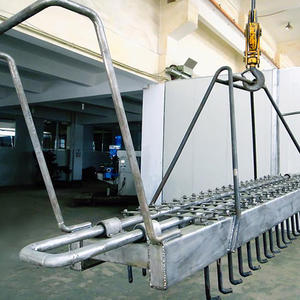Electrolytic refining of copper is the electrolytic purification of copper: thick copper is pre-made into a thick plate as an anode, and pure copper is made into a thin sheet as a cathode, and a mixture of sulfuric acid and copper sulfate is used as an electrolyte. After electrification, copper dissolves from the anode into copper ions Move to the cathode, get electrons after reaching the cathode and precipitate pure copper at the cathode. Impurities in crude copper, such as iron and zinc, which are more active than copper, will dissolve into ions together with copper, but because these ions are less active than copper, they are not easy to precipitate compared with copper ions, so it can be avoided by properly adjusting the potential difference during electrolysis. These ions are precipitated on the anode, and impurities less reactive than copper, such as gold and silver, are deposited on the bottom of the electrolytic cell. The copper plate produced in this way is called "electrolytic copper", which is extremely pure and can be used to make electrical products. The purity of electrolytically refined copper can reach 99.95%, which is quite pure copper.

Copper electrolytic refining process introduction:
The product of copper fire refining is blister copper containing 99.0% to 99.6% copper. Due to its low purity, it cannot meet the requirements of industrialization. Therefore, it must be electrolytic refining to remove impurities that are difficult to remove in fire refining. Use pure copper flakes as the cathode, put the cathode and anode in the electrolytic cell, use sulfuric acid and copper sulfate aqueous solution as the electrolyte, and under the action of direct current, the copper on the anode dissolves and enters the solution, and the copper in the solution is on the cathode. Precipitate. During this process, the metals on the anode that are negativer than the copper potential enter the solution, but cannot be precipitated on the cathode, and remain in the electrolyte to be removed during the purification process of the electrolyte; noble metals and some metals are more positive than the copper dissolution potential due to their potential It is insoluble and precipitates at the bottom of the tank to become anode slime. In this way, the metal copper precipitated on the cathode is of high purity, which is called cathode copper or electric copper.
The purpose of electrolytic refining is to:
(1) Reduce the impurity content in copper, thereby improving the performance of copper and making it meet the requirements of various applications;
(2) Recovery of valuable metals, especially precious metals and scattered metals.
During the electrolysis process, the copper in the solution is preferentially precipitated on the cathode, while other base metals with negative potential cannot be precipitated on the cathode and remain in the electrolyte to be removed when the electrolyte is regularly purified. In this way, the metal copper precipitated on the cathode The purity is very high, called cathode copper or electrolytic copper, referred to as electric copper. Understand>>>Semi automatic cathode stripping machine
Introduction of Copper Electrolytic Refining Process
The copper electrolytic refining process has been applied in industry for the first time in 1896. It has a history of 140 years. made great progress.
In the electrolysis workshop, depending on the production scale, there are usually hundreds or thousands of electrolytic cells. In the workshop, the cells are placed in parallel. In each cell, the single-chip anode is connected in parallel, and the single-chip cathode It is connected in parallel with the cathode, and the direct current between the tanks is connected in series. The cathode and anode of the entire electrolysis workshop are charged, but because the tank voltage is not high (0.3 volts), it will not cause harm to the human body. The electrolyte in the electrolytic cell is in constant circulation, and it circulates once every 2 to 3 hours. During the circulation of the electrolyte, a heating device is also provided to ensure a constant temperature of the electrolyte.
 English
English  Español
Español  Português
Português  русский
русский  français
français  日本語
日本語  Deutsch
Deutsch  Tiếng Việt
Tiếng Việt  Italiano
Italiano  Nederlands
Nederlands  ไทย
ไทย  Polski
Polski  한국어
한국어  Svenska
Svenska  Malay
Malay  বাংলা
বাংলা  हिन्दी
हिन्दी  Pilipino
Pilipino  Türk
Türk  عربى
عربى  Indonesia
Indonesia  norsk
norsk  čeština
čeština  Українська
Українська  Javanese
Javanese  فارسی
فارسی  తెలుగు
తెలుగు  Burmese
Burmese  български
български  Latine
Latine  Azərbaycan
Azərbaycan  Српски
Српски  Esperanto
Esperanto  Afrikaans
Afrikaans  Català
Català  Cymraeg
Cymraeg  Беларус
Беларус  Hrvatski
Hrvatski  Kreyòl ayisyen
Kreyòl ayisyen  Shqiptar
Shqiptar  Bosanski
Bosanski  Кыргыз тили
Кыргыз тили  ಕನ್ನಡ
ಕನ್ನಡ  IsiXhosa
IsiXhosa  Chichewa
Chichewa  Somali
Somali  O'zbek
O'zbek  հայերեն
հայերեն  Sundanese
Sundanese  Malagasy
Malagasy 






